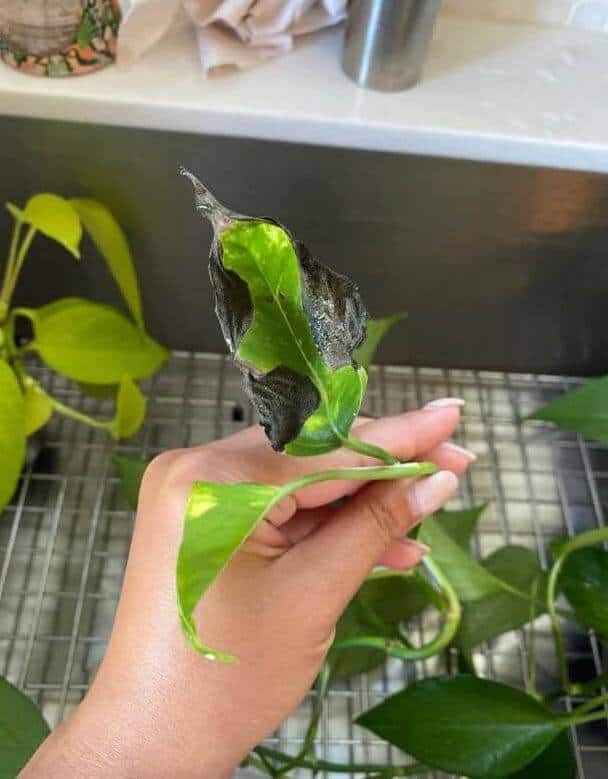Last Updated on June 26, 2023 by a Friendly Gardener
Pothos plants rank among the most popular houseplants due to their ease of care and beautiful cascading foliage. Nonetheless, despite not being fussy, they are not immune to issues. When pothos leaves begin to turn black, they are communicating distress, but don’t fret! By correcting Pothos’ care, your plant will be perky and green in no time.
Pothos Plant Black Leaves

When you first notice your pothos leaves turning black, you may fear the worst. Undoubtedly, something is wrong with your plant’s care routine. But most issues can be easily corrected. Generally, pothos leaves turning black is due above all to overwatering, but there are some other causes of leaf discoloration. Here are some of the most common.
Overwatering a Pothos Plant
This is the principal cause of pothos foliage turning black. Pothos plants, like all houseplants, need water, but when they receive too much, the foliage will begin to wilt and gradually turn black. This type of excessive moisture can also create the perfect environment for root rot to set in or other types of fungal infection.
What to Do
Reduce the amount of water you are giving your plant. Only water it if the topsoil feels dry to a depth of two inches.
Insufficient Drainage
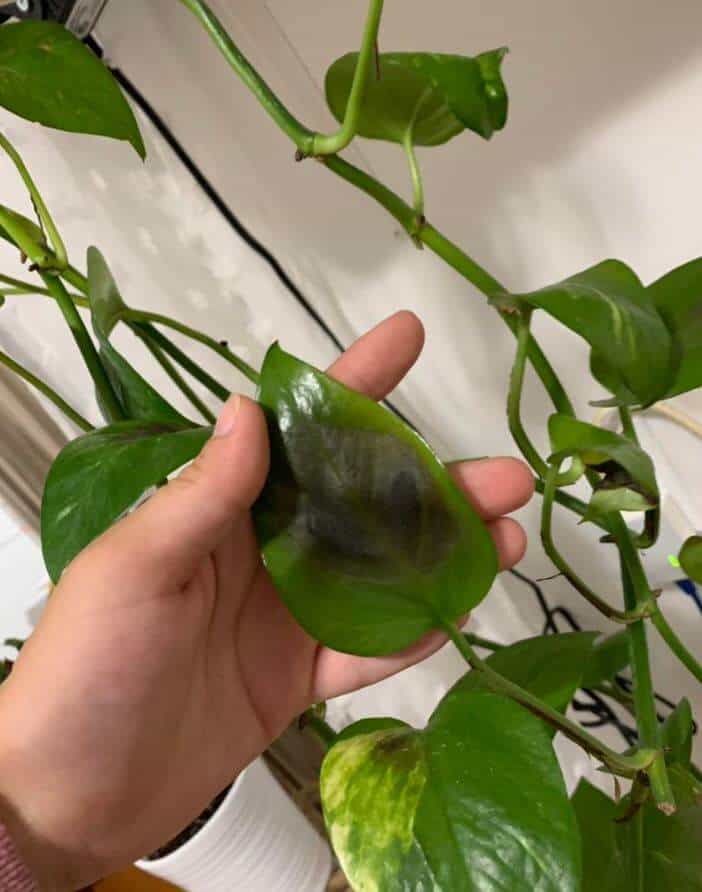
You may not be overwatering your plant, but your plant may feel that you are. This can be due to insufficient drainage when you do water. Inadequate drainage can cause the same type of issue as overwatering because your plant’s root system is left standing on water. Typical symptoms of improper drainage include a musty odor, wilting or limp leaves, soggy soil, stunted growth, and water blisters.
What to Do
Check for blocked drainage holes and compacted soil. When soil becomes compacted it can become soggy because water flow is obstructed. This can lead to root rot. Repot your pothos if necessary.
Underwatering a Pothos Plant
While overwatering may be the most common pothos issue, underwatering can be just as harmful. A lack of water will cause your plant to dehydrate. Leaves will turn dry, crispy, and become blackened. A pothos left for longer periods without water will eventually die.
What to Do
Water your plant when it is thirsty. Touch test the soil bed for dryness and water when the soil bed feels dry at least two inches deep.
Excessive Sunlight Exposure
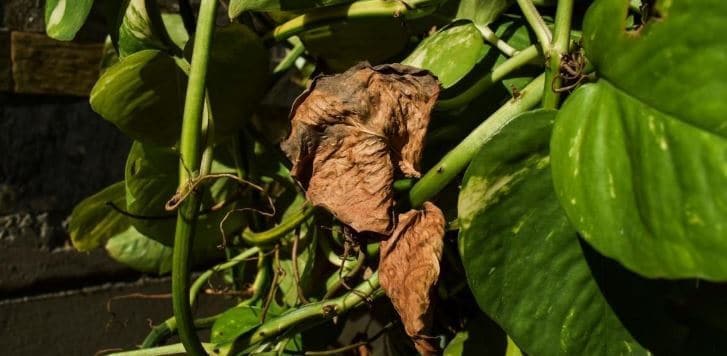
A black pothos plant may also be a result of your plant receiving too much sunlight. A pothos plant should never be left sitting in direct sunlight. It does enjoy bright indirect light and needs light to survive, but too much will be detrimental. Too little light can also cause black tips to form on foliage.
What to Do
Change your Pothos plant’s location. Place it in bright but indirect light.
Excessive Fertilization
Any healthcare professional would tell you that one piece of cake is better than eating the entire cake. Fertilization often exerts the same type of stress on houseplants. Occasional fertilization is a good thing, but overfeeding your pothos plant can cause salt buildup in the soil bed, burn root systems and foliage, cause stunted growth and cause leaves to turn black.
What to Do
Avoid overfertilization by only feeding your pothos during the growing season in spring, summer, and fall. Use a balanced liquid fertilizer for foliage plants and dilute it to prevent burning root systems. Apply fertilizer after you have watered. Flush your plant’s soil every few months to prevent salt buildup.
Improper Environmental Temperatures
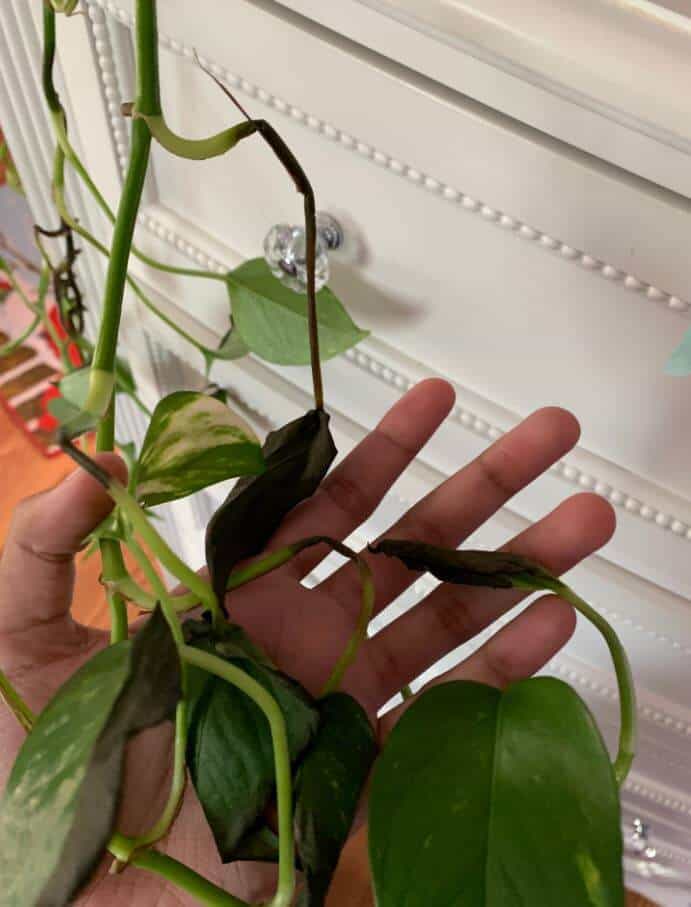
The pothos is a Southeastern Asian native of the tropics. It likes comfortably warm temperatures that measure between 70° and 90° F. When they are exposed to cold or cool temperatures, foliage may begin to wilt and turn black. Its growth habit may also appear stunted.
What to Do
Keep your pothos in a room with the proper temperature for their growth habit. Avoid spots where temperatures drop below 55°F. Also keep your plant away from air conditioning and heating vents as well as drafty windows, doors, or corridors.
Pest Infestations
Pest do not limit their visits to outdoor plants, they love any plant, including your houseplants. Various breeds of sapsuckers are particularly problematic. These include thrips, spider mites, aphids, and mealybugs. These sap suckers have sharp mouths that are capable of piercing plant stems and foliage to suck out the juices. If a plant is overrun with pests, pothos foliage can turn black, wilt, and drop.
What to Do
Treat your pothos with insecticidal soap or neem oil. Avoid using chemical pesticides.
Infections and Diseases
Pothos leaves turning black is not as common when it comes to diseases and infections, however, it can happen. Bacterial blight is an infection that can cause pothos plant black spots on stems and foliage. Bacterial leaf spot can do the same to pothos plants.
Pothos plant black spots are typical when a bacterial or fungal infection strikes a plant. The best defense is to avoid overwatering or improper drainage.
What to Do
Bacterial and fungal infections must be treated immediately if you want to save your plant. Spray your pothos plant with a fungicide or with neem oil which is a natural, organic pesticide and fungicide. Isolate your plant from other houseplants to prevent an infection from spreading. If the plant is severely infected, it may be wiser to eliminate it.
How to Fix Pothos Plant Black Leaves
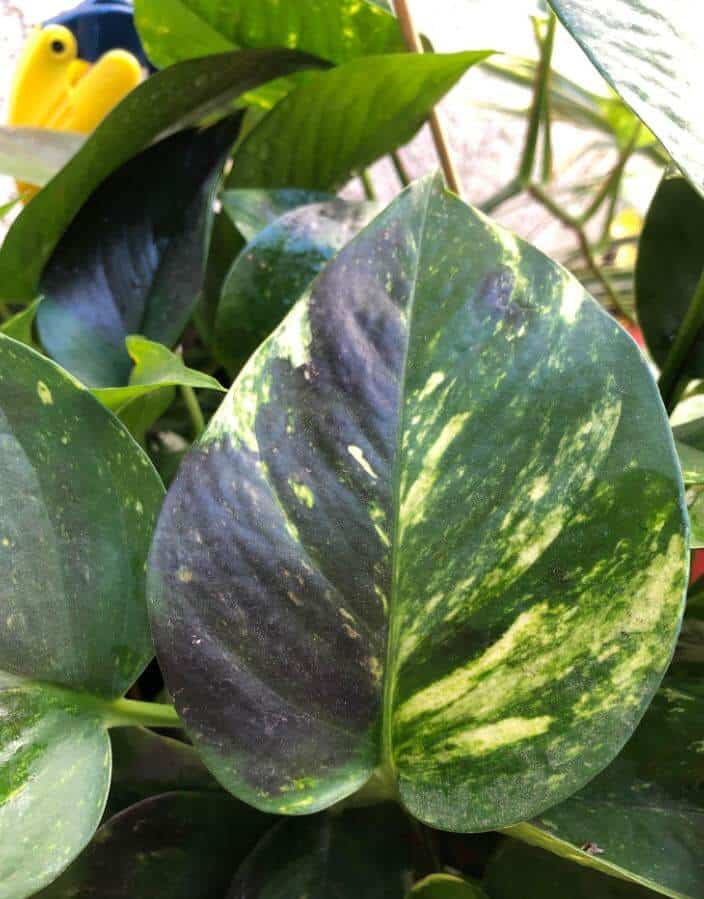
The best method for combatting pothos black leaves is to take the necessary steps to ensure proper care and an appropriate growing environment. If your pothos starts to develop black leaves or black spots, this indicates that the issue causing black foliage is relatively advanced and this makes dealing with this particular symptom all the more challenging. If you are able to deal with issues before they become uncontrollable, you will have a better chance of returning your pothos to good health.

